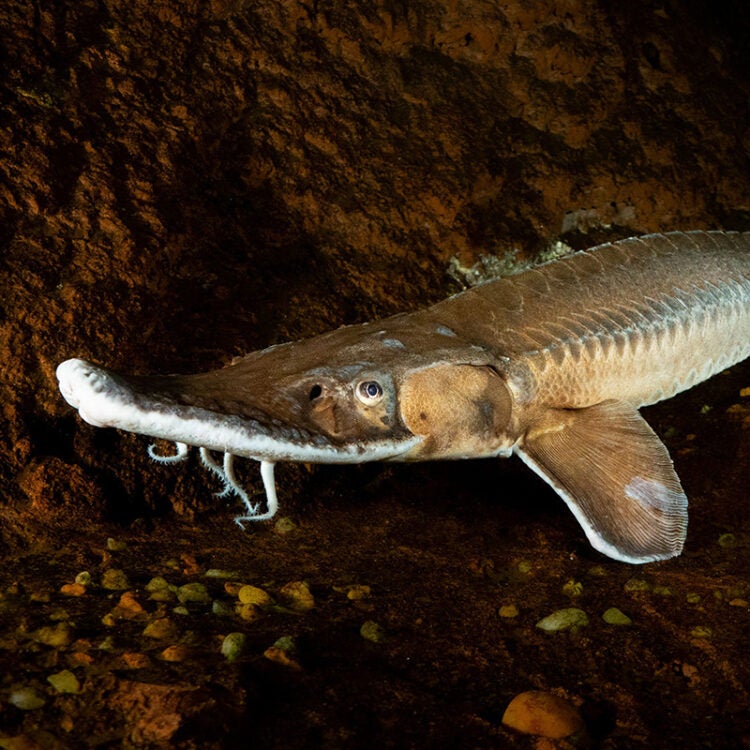-
Size
3.3 feet (1 m) -
Diet
Aquatic insect larvae, burrowing mayflies, caddisfly larvae -
Range
North America -
Habitat
Bottom of main channels and bays of large, turbid rivers, where currents are strong
Physical Characteristics
- Has a broad shovel-shaped snout with four fringed barbels in front of its mouth, which is on the underside of its head.
- Upper and lower lips each have four distinct fleshy lobes.
- The body tapers abruptly towards the tail. The caudal peduncle is slender and well armored, flat in cross section and covered with bony plates.
- Scale-like scutes, or bony external plates, cover the belly except on the smallest young.
- Pale to medium gray or brownish dorsally and white below.
- The maximum length is recorded at 3.3 feet (1 m) and the maximum published weight is 11 lbs. (5 kg).
Animal Fact
Shovelnose sturgeons use barbels to detect prey at the bottom of rivers.
Diet / Feeding
- Diet consists of aquatic insect larvae, especially burrowing mayflies and caddisfly larvae.
- Cruises the bottom of the rivers where it detects prey with sensitive barbels and vacuums the food items up through its long tubular mouth.
Range / Habitat
- Originally occurs in large rivers of the Mississippi River basin from Montana to Louisiana; the Mobile Bay drainage in Alabama and Mississippi; the Tennessee River; and the Upper Rio Grande in New Mexico. The fish now is common in the Mississippi Basin, rare in Mobile Bay drainage and extinct in the Rio Grande.
- Found at the bottom of main channels and bays of large, turbid rivers, where currents are strong enough to keep the gravel substrate clear of silt.
- Usually found in depths of 6-23 feet (2-7 m).
Reproduction & Growth
- Oviparous- egg-laying species.
- Spawning is reported to occur from April to June in large rivers in areas with rocky substrates and swift currents.
Conservation Status
- “Vulnerable” on the IUCN Red List.
- International trade has been restricted under CITES Appendix II since 1998.
- Overall, its numbers have decreased sharply since 1900, but it still remains abundant off the main channels of the Missouri and Mississippi rivers.
- Has not been seen in Alabama during the last half-century and is thought to be extinct there.
Additional Information
- Slow-growing fish that is long-lived, some attaining 43 years of age or more.
- It is the most common mid-American sturgeon.
- At one time it was considered a nuisance by fishermen. however, after about 1900, the shovelnose sturgeon was recognized as being valuable as a smoked fish product and its roe is valued as caviar.
- In past years, this sturgeon was exploited as food and byproducts. Today, the industry processes only a small fraction of the historic peak catch numbers.
Sources
- www.fishbase.org
- Peterson Field Guides: Freshwater Fishes. Page, L. and Burr, B., pgs. 27 – 28
- Fishes of Alabama. Boschung Jr., H. T. and Mayden, R. L., pgs. 107 -108
- The Fishes of Tennessee. Etnier, D. A. and Starnes, W. C., pgs 102 -103






